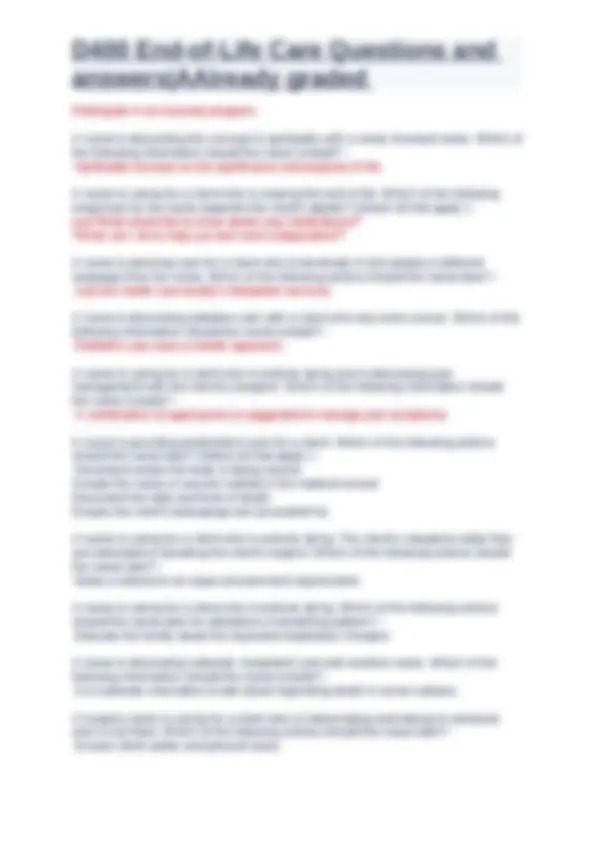



Study with the several resources on Docsity

Earn points by helping other students or get them with a premium plan


Prepare for your exams
Study with the several resources on Docsity

Earn points to download
Earn points by helping other students or get them with a premium plan
Community
Ask the community for help and clear up your study doubts
Discover the best universities in your country according to Docsity users
Free resources
Download our free guides on studying techniques, anxiety management strategies, and thesis advice from Docsity tutors
A comprehensive q&a guide for nurses on end-of-life care, covering topics such as defining a 'good death', benefits of palliative care, managing isolation, hospice care services, client's noisy respirations, spirituality, client's dignity, language barriers, palliative care for colon cancer, pain management, postmortem care, organ donation, alterations in breathing pattern, culturally competent care, and hallucinations in hospice care.
Typology: Exams
1 / 2

This page cannot be seen from the preview
Don't miss anything!


A nurse is caring for a client who has a terminal illness and states that they want to experience a "good death." Which of the following actions should the nurse take? - Determine the client's definition of a "good death." A nurse is discussing the benefits of palliative care with a newly licensed nurse. Which of the following information should the nurse include? - Palliative care improves the client's quality of life. A nurse is caring for a client who has a terminal illness and reports feeling isolated from family and friends. Which of the following actions should the nurse take? - Assist in scheduling friends and family to visit. A nurse is reviewing hospice care services with a group of newly hired nurses. Which of the following information should the nurse include? - Hospice care is an interdisciplinary team effort. A nurse is caring for a client who is actively dying. The client's caregiver asks the nurse about the client's noisy respirations. Which of the following information should the nurse include? (Select all that apply.) - They can be an indication of approaching death. Turning the client's head to the side can assist with drainage. Medications can be administered to help dry up the secretions. The client is unable to clear the secretions themselves. A nurse is discussing hospice care services with the caregiver of a client who is terminally ill. Which of the following information should the nurse include? - Nursing support will be provided in meeting the client's daily needs, including the administration of medications. A nurse is teaching a client about hospice care. Which of the following information should the nurse include? (Select all that apply.) - "You must have a terminal illness." "You accept palliative care for comfort." "The health care provider must officially state that you are terminally ill." A nurse is caring for a client who is actively dying and notes the client's feet are purple and marbled. Which of the following findings should the nurse expect? - Mottling is visible on the client's legs. A nurse is grieving following the death of a client who had a terminal illness and is having difficulty sleeping and concentrating. Which of the following actions should the nurse take? -
Participate in an exercise program. A nurse is discussing the concept of spirituality with a newly licensed nurse. Which of the following information should the nurse include? - Spirituality focuses on the significance and purpose of life. A nurse is caring for a client who is nearing the end of life. Which of the following responses by the nurse supports the client's dignity? (Select all that apply.) - you"What would like to know about your medications?" "What can I do to help you feel more independent?" A nurse is planning care for a client who is terminally ill and speaks a different language than the nurse. Which of the following actions should the nurse take? - Use the health care facility's interpreter services. A nurse is discussing palliative care with a client who has colon cancer. Which of the following information should the nurse include? - Palliative care uses a holistic approach. A nurse is caring for a client who is actively dying and is discussing pain management with the client's caregiver. Which of the following information should the nurse include? - A combination of approaches is suggested to manage pain symptoms. A nurse is providing postmortem care for a client. Which of the following actions should the nurse take? (Select all that apply.) - Document where the body is being moved. Include the name of anyone notified in the medical record. Document the date and time of death. Ensure the client's belongings are accounted for. A nurse is caring for a client who is actively dying. The client's caregivers state they are interested in donating the client's organs. Which of the following actions should the nurse take? - Make a referral to an organ procurement organization. A nurse is caring for a client who is actively dying. Which of the following actions should the nurse take for alterations in breathing pattern? - Educate the family about the expected respiratory changes. A nurse is discussing culturally competent care with another nurse. Which of the following information should the nurse include? - It is culturally insensitive to talk about impending death in some cultures. A hospice nurse is caring for a client who is hallucinating and talking to someone who is not there. Which of the following actions should the nurse take? - Ensure client safety and prevent injury.